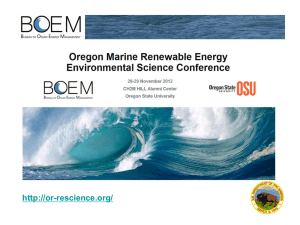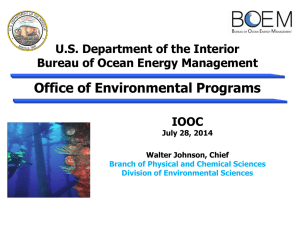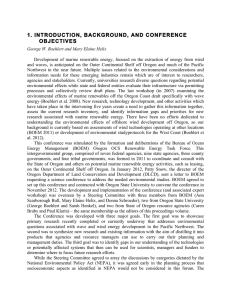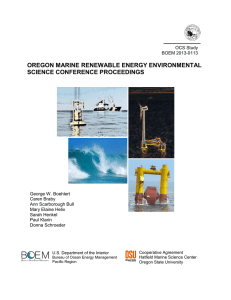7. NEXT STEPS AND CONCLUDING REMARKS
advertisement
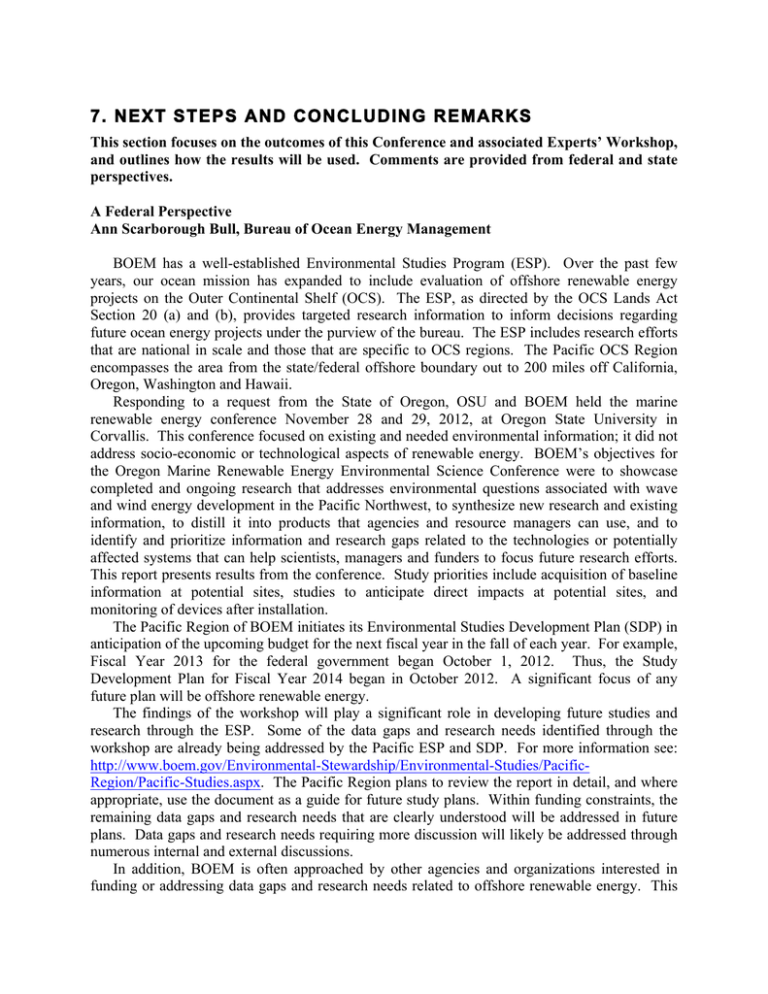
7. NEXT STEPS AND CONCLUDING REMARKS This section focuses on the outcomes of this Conference and associated Experts’ Workshop, and outlines how the results will be used. Comments are provided from federal and state perspectives. A Federal Perspective Ann Scarborough Bull, Bureau of Ocean Energy Management BOEM has a well-established Environmental Studies Program (ESP). Over the past few years, our ocean mission has expanded to include evaluation of offshore renewable energy projects on the Outer Continental Shelf (OCS). The ESP, as directed by the OCS Lands Act Section 20 (a) and (b), provides targeted research information to inform decisions regarding future ocean energy projects under the purview of the bureau. The ESP includes research efforts that are national in scale and those that are specific to OCS regions. The Pacific OCS Region encompasses the area from the state/federal offshore boundary out to 200 miles off California, Oregon, Washington and Hawaii. Responding to a request from the State of Oregon, OSU and BOEM held the marine renewable energy conference November 28 and 29, 2012, at Oregon State University in Corvallis. This conference focused on existing and needed environmental information; it did not address socio-economic or technological aspects of renewable energy. BOEM’s objectives for the Oregon Marine Renewable Energy Environmental Science Conference were to showcase completed and ongoing research that addresses environmental questions associated with wave and wind energy development in the Pacific Northwest, to synthesize new research and existing information, to distill it into products that agencies and resource managers can use, and to identify and prioritize information and research gaps related to the technologies or potentially affected systems that can help scientists, managers and funders to focus future research efforts. This report presents results from the conference. Study priorities include acquisition of baseline information at potential sites, studies to anticipate direct impacts at potential sites, and monitoring of devices after installation. The Pacific Region of BOEM initiates its Environmental Studies Development Plan (SDP) in anticipation of the upcoming budget for the next fiscal year in the fall of each year. For example, Fiscal Year 2013 for the federal government began October 1, 2012. Thus, the Study Development Plan for Fiscal Year 2014 began in October 2012. A significant focus of any future plan will be offshore renewable energy. The findings of the workshop will play a significant role in developing future studies and research through the ESP. Some of the data gaps and research needs identified through the workshop are already being addressed by the Pacific ESP and SDP. For more information see: http://www.boem.gov/Environmental-Stewardship/Environmental-Studies/PacificRegion/Pacific-Studies.aspx. The Pacific Region plans to review the report in detail, and where appropriate, use the document as a guide for future study plans. Within funding constraints, the remaining data gaps and research needs that are clearly understood will be addressed in future plans. Data gaps and research needs requiring more discussion will likely be addressed through numerous internal and external discussions. In addition, BOEM is often approached by other agencies and organizations interested in funding or addressing data gaps and research needs related to offshore renewable energy. This workshop summary is also intended to benefit those agencies and organizations. It is important to note that funding fluctuates from year to year. Over the past several years, the Pacific Region has averaged three to five new studies each year. More studies are proposed than can be funded in any one year. A State of Oregon Perspective Caren Braby, Oregon Department of Fish and Wildlife Paul Klarin, Oregon Department of Land Conservation and Development While Oregon has created an innovative marine spatial planning decision support tool with over 200 data layers, the state continues to need additional information to ground truth assumptions, fill in information gaps, reduce uncertainties, and provide expert opinions. In addition, the state is working with other West Coast states to create a regional data framework that will facilitate regional decision-making and planning efforts. The State of Oregon has used existing data for baseline environmental information rather than relying on new data collection to determine the areas of Oregon’s territorial sea (0-3 miles) with the greatest abundance or the most valuable (i.e., legally most important to protect, rarest, etc.) ecological resources. In compiling these data, we recognize that there are many ways to improve the information on which decision-making related to ecological resources is based; in some areas there are no data, while in others data needs to be improved (e.g., better geographical coverage, more recent data, etc.). We also recognize that filling information gaps is an ongoing and continuous process that will requires collaboration among agencies and academics.. The gap analysis and prioritization exercise from this Conference and Experts’ Workshop will provide additional information on which research areas are most important, informing our long-term plans for research and collaboration. In addition, we have focused more on baseline data gaps and needs than on impacts or monitoring needs, since we have yet to get “steel in the water.” The prioritization exercise herein will help us transition to focusing on these later stages in the development process, and will help us promote and/or seek ways to fill the most important data gaps for both the territorial sea and the Outer Continental Shelf.
